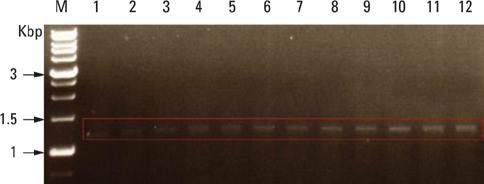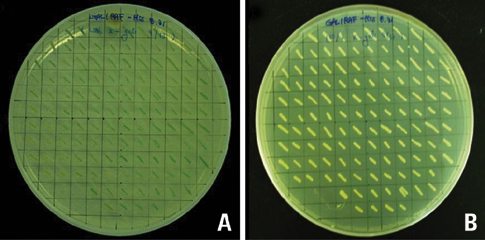Yonsei Med J.
2009 Apr;50(2):273-279.
Identification of Proteins That Interact with Podocin Using the Yeast 2-Hybrid System
- Affiliations
-
- 1Clinical Research Center, Samsung Biomedical Research Institute, Sungkyunkwan University School of Medicine, Seoul, Korea.
- 2Division of Nephrology, Samsung Medical Center, Sungkyunkwan University School of Medicine, Seoul, Korea. kimdjsmc@dreamwiz.com
Abstract
- PURPOSE
As a membrane protein at the insertion site of the slit diaphragm (SD) complex in podocyte foot processes, podocin has been reported to act as a scaffolding protein required to maintain or regulate the structural integrity of the SD. In order to identify proteins that associate or interact with podocin, we screened a mouse kidney complementary DNA (cDNA) library using a yeast 2-hybrid system. MATERIALS AND METHODS: 1) The full-length cDNA of podocin from the mouse kidney was amplified by Polymerase Chain Reaction (PCR), 2) The PCR product was cloned into a pGBKT7 vector, pGBKT7-podocin, 3) After the pGBKT7-podocin was transformed into AH109, the AH109/pGBKT7-podocin product was obtained, 4) The mouse kidney cDNA library was transformed into the AH109/pGBKT7-podocin and screened by selection steps, 5) Next, twelve clones were cultured and isolated, 6) The yeast-purified plasmids were transformed into Escherichia coli (E. coli) by heat shock, and 7) To identify the activation domain (AD)/library inserts, we digested them with Him III, and the fragments were then sequenced. RESULTS: 12 positive clones that interacted with podocin were obtained by screening a mouse kidney cDNA library using pGBKT7-podocin. Among them, only 4 clones were found to function at the podocyte where podocin is present. CONCLUSION: Additional studies are needed to clarify the role and interaction with podocin and candidates.
MeSH Terms
Figure
Reference
-
1. Roselli S, Gribouval O, Boute N, Sich M, Benessy F, Attié T, et al. Podocin localizes in the kidney to the slit diaphragm area. Am J Pathol. 2002. 160:131–139.
Article2. Smoyer WE, Mundel P. Regulation of podocyte structure during the development of nephrotic syndrome. J Mol Med. 1998. 76:172–183.
Article3. Somlo S, Mundel P. Getting a foothold in nephrotic syndrome. Nat Genet. 2000. 24:333–335.
Article4. Farquhar MG, Vernier RL, Good RA. An electron microscope study of the glomerulus in nephrosis, glomerulonephritis, and lupus erythematosus. J Exp Med. 1957. 106:649–660.
Article5. Caulfield JP, Reid JJ, Farquhar MG. Alterations of the glomerular epithelium in acute aminonucleoside nephrosis. Evidence for formation of occluding junctions and epithelial cell detachment. Lab Invest. 1976. 34:43–59.6. Ito K, Ger YC, Kawamura S. Actin filament alterations in glomerular epithelial cells of adriamycin-incuded nephrotic rats. Acta Pathol Jpn. 1986. 36:253–260.
Article7. Ryan GB, Karnovsky MJ. An ultrastructural study of the mechanisms of proteinuria in aminonucleoside nephrosis. Kidney Int. 1975. 8:219–232.
Article8. Vernier RL, Papermaster BW, Good RA. Aminonucleoside nephrosis. I. Electron microscopic study of the renal lesion in rats. J Exp Med. 1959. 109:115–126.9. Boute N, Gribouval O, Roselli S, Benessy F, Lee H, Fuchshuber A, et al. NPHS2, encoding the glomerular protein podocin, is mutated in autosomal recessive steroid-resistant nephrotic syndrome. Nat Genet. 2000. 24:349–354.
Article10. Shih NY, Li J, Karpitskii V, Nguyen A, Dustin ML, Kanagawa O, et al. Congenital nephrotic syndrome in mice lacking CD2-associated protein. Science. 1999. 286:312–315.
Article11. Donoviel DB, Freed DD, Vogel H, Potter DG, Hawkins E, Barrish JP, et al. Proteinuria and perinatal lethality in mice lacking NEPH1, a novel protein with homology to NEPHRIN. Mol Cell Biol. 2001. 21:4829–4836.
Article12. Schwarz K, Simons M, Reiser J, Saleem MA, Faul C, Kriz W, et al. Podocin, a raft-associated component of the glomerular slit diaphragm, interacts with CD2AP and nephrin. J Clin Invest. 2001. 108:1621–1629.
Article13. Sambrook J, Russel DW. Sambrook J, Russel DW, editors. Preparation and transformation of competent E. coli. Molecular Coning. 1989. New York: Cold Spring Harbor Laboratory Press.14. Daniels BS, Deen WM, Mayer G, Meyer T, Hostetter TH. Glomerular permeability barrier in the rat. Functional assessment by in vitro methods. J Clin Invest. 1993. 92:929–936.
Article15. Drumond MC, Deen WM. Structural determinants of glomerular hydraulic permeability. Am J Physiol. 1994. 266(1 Pt 2):F1–F12.
Article16. Putaala H, Soininen R, Kilpeläinen P, Wartiovaara J, Tryggvason K. The murine nephrin gene is specifically expressed in kidney, brain and pancreas: inactivation of the gene leads to massive proteinuria and neonatal death. Hum Mol Genet. 2001. 10:1–8.
Article17. Holzman LB, St John PL, Kovari IA, Verma R, Holthofer H, Abrahamson DR. Nephrin localizes to the slit pore of the glomerular epithelial cell. Kidney Int. 1999. 56:1481–1491.
Article18. Ruotsalainen V, Ljungberg P, Wartiovaara J, Lenkkeri U, Kestilä M, Jalanko J, et al. Nephrin is specifically located at the slit diaphragm of glomerular podocytes. Proc Natl Acad Sci U S A. 1999. 96:7962–7967.
Article19. Holthöfer H, Ahola H, Solin ML, Wang S, Palmen T, Luimula P, et al. Nephrin localizes at the podocyte filtration slit area and is characteristically spliced in the human kidney. Am J Pathol. 1999. 155:1681–1687.
Article20. Kestilä M, Lenkkeri U, Männikkö M, Lamerdin J, McCready P, Putaala H, et al. Positionally cloned gene for a novel glomerular protein--nephrin--is mutated in congenital nephrotic syndrome. Mol Cell. 1998. 1:575–582.
Article21. Boute N, Gribouval O, Roselli S, Benessy F, Lee H, Fuchshuber A, et al. NPHS2, encoding the glomerular protein podocin, is mutated in autosomal recessive steroid-resistant nephrotic syndrome. Nat Genet. 2000. 24:349–354.
Article22. Fuchshuber A, Jean G, Gribouval O, Gubler MC, Broyer M, Beckmann JS, et al. Mapping a gene (SRN1) to chromosome 1q25-q31 in idiopathic nephrotic syndrome confirms a distinct entity of autosomal recessive nephrosis. Hum Mol Genet. 1995. 4:2155–2158.
Article23. Fields S, Song O. A novel genetic system to detect protein-protein interactions. Nature. 1989. 340:245–246.
Article24. Uetz P, Giot L, Cagney G, Mansfield TA, Judson RS, Knight JR, et al. A comprehensive analysis of protein-protein interactions in Saccharomyces cerevisiae. Nature. 2000. 403:623–627.
Article25. Ito T, Chiba T, Ozawa R, Yoshida M, Hattori M, Sakaki Y. A comprehensive two-hybrid analysis to explore the yeast protein interactome. Proc Natl Acad Sci U S A. 2001. 98:4569–4574.
Article26. Ito T, Tashiro K, Muta S, Ozawa R, Chiba T, Nishzawa M, et al. Toward a protein-protein interaction map of the budding yeast: A comprehensive system to examine two-hybrid interactions in all possible combinations between the yeast proteins. Proc Natl Acad Sci U S A. 2000. 97:1143–1147.
Article27. Hu JC. A guided tour in protein of interaction space: coiled coils from the yeast proteome. Proc Natl Acad Sci U S A. 2000. 97:12935–12936.
Article28. Kobayashi N, Mundel P. A role of microtubules during in the formation of cell processes in neuronal and non-neuronal cells. Cell Tissue Res. 1998. 291:163–174.
Article29. Baas PW. Microtubules and neuronal polarity: lessons from mitosis. Neuron. 1999. 22:23–31.30. Nislow C, Lombillo VA, Kuriyama R, McIntosh JR. A plus-end-directed motor enzyme that moves antiparallel microtubules in vitro localizes to the interzone of mitotic spindles. Nature. 1992. 359:543–547.
Article31. Kobayashi N, Reiser J, Kriz W, Kuriyama R, Mundel P. Nonuniform microtubular polarity, established by CHO1/MKLP1 motor protein, is necessary for process formation of podocytes. J Cell Biol. 1998. 143:1961–1970.
Article32. Sharp DJ, Yu W, Ferhat L, Kuriyama R, Rueger D, Baas PW. Identification of a microtubule-associated motor protein essential for dendritic differentiation. J Cell Biol. 1997. 138:833–843.
Article33. Yu W, Sharp DJ, Kuriyama R, Mallik P, Baas PW. Inhibition of a mitotic motor compromises the formation of dendrite-like processes from neuroblastoma cells. J Cell Biol. 1997. 136:659–668.
Article34. Yu W, Cook C, Sauter C, Kuriyama R, Kaplan PL, Baas PW. Depletion of a microtubule-associated motor protein induces the loss of dendritic identity. J Neurosci. 2000. 20:5782–5791.
Article35. Gwinner W, Landmesser U, Brandes RP, Kubat B, Plasger J, Eberhard O, et al. Reactive oxygen species and antioxidant defense in puromycin aminonucleoside glomerulopathy. J Am Soc Nephrol. 1997. 8:1722–1731.
Article36. Wang JS, Yang AH, Chen SM, Young TK, Chiang H, Liu HC. Amelioration of antioxidant enzyme suppression and proteinuria in cyclosporin-treated puromycin nephrosis. Nephron. 1993. 65:418–425.
Article37. Trachtman H, Schwob N, Maesaka J, Valderrama E. Dietary vitamin E supplementation ameliorates renal injury in chronic puromycin aminonucleoside nephropathy. J Am Soc Nephrol. 1995. 5:1811–1819.
Article38. Kawamura T, Yoshioka T, Bills T, Fogo A, Ichikawa I. Glucocorticoid activates glomerular antioxidant enzymes and protects glomeruli from oxidant injuries. Kidney Int. 1991. 40:291–301.
Article39. Srivastava RN, Diven S, Kalia A, Travis LB, Ansari NH. Increased glomerular and urinary malondialdehyde in puromycin aminonucleoside-induced proteinuria in rats. Pediatr Nephrol. 1995. 9:48–51.
Article40. Fiegelson EB, Drake JW, Recant L. Experimental aminonucleoside nephrosis in rats. J Lab Clin Med. 1957. 50:437–446.41. Vega-Warner V, Ransom RF, Vincent AM, Brosius FC, Smoyer WE. Induction of antioxidant enzymes in murine podocytes precedes injury by puromycin aminonucleoside. Kidney Int. 2004. 66:1881–1889.
Article42. Breyer MD, Badr FK. Brenner BM, editor. Arachidonic acid metabolites and the kidney. The Kidney. 1996. 5th. Philadelphia: WB Saunders.43. Schmitz PG, Kasiske BL, O'Donnell MP, Keane WF. Lipids and progressive renal injury. Semin Nephrol. 1989. 9:354–369.44. Peeters RA, Veerkamp JH, Demel RA. Are fatty acid-binding proteins involved in fatty acid transfer? Biochim Biophys Acta. 1989. 1002:8–13.
Article45. Glatz JF, Börchers T, Spener F, van der Vusse GJ. Fatty acids in cell signalling: modulation by lipid binding proteins. Prostaglandins Leukot Essent Fatty Acids. 1995. 52:121–127.
Article46. Kimura H, Fujii H, Suzuki S, Ono T, Arakawa M, Gejyo F. Lipid-binding proteins in rat and human kidney. Kidney Int Suppl. 1999. 71:S159–S162.
Article47. Nguyen HH, Baricos WH, Shah SV. Degradation of glomerular basement membrane by a neutral metalloproteinase(s) present in glomeruli isolated from normal rat kidney. Biochem Biophys Res Commun. 1986. 141:898–903.
Article48. Le Q, Shah S, Nguyen J, Cortez S, Baricos W. A novel metalloproteinase present in freshly isolated rat glomeruli. Am J Physiol. 1991. 260(4 pt 2):F555–F561.
Article49. Baricos WH, Cortez SL, Le QC, Zhou YW, Dicarlo RM, O'Conno SE, et al. Glomerular basement membrane degradation by endogenous cysteine proteinases in isolated rat glomeruli. Kidney Int. 1990. 38:395–401.
Article50. Baricos WH, Shah SV. Proteolytic enzymes as mediators of glomerular injury. Kidney Int. 1991. 40:161–173.
Article51. Katunuma N, Kominami E. Structures and functions of lysosomal thiol proteinases and their endogenous inhibitor. Curr Top Cell Regul. 1983. 22:71–101.
Article52. In : Kirschke H, Langner J, Riemann S, Wiederanders B, Ansorge S, Bohley P, editors. Lysosomal cysteine proteinases. Protein degradation in health and disease. 1980. Elsevier, Ciba Foundation Synposium 75; Amsterdam: Excerpta medica.
Article53. Steiner DF, Docherty K, Chan SJ, San Segundo B, Carroll B. Koch G, Richter D, editors. Intracellular proteolytic mechanisms in the biosynthesis of hormones and peptide neurotransmitters. Biochemical and clinical aspects of neuropeptides: synthesis, processing, and gene structure. 1983. London, New York: Academic Press.
Article54. Kriz W, Hähnel B, Rösener S, Elger M. Long-term treatment of rats with FGF-2 results in focal segmental glomerulosclerosis. Kidney Int. 1995. 48:1435–1450.
Article55. Kopp JB, Factor VM, Mozes M, Nagy P, Sanderson N, Böttinger EP, et al. Transgenic mice with increased plasma levels of TGF-beta 1 develop progressive renal disease. Lab Invest. 1996. 74:991–1003.56. Gesualdo L, Pinzani M, Floriano JJ, Hassan MO, Nagy NU, Schena FP, et al. Platelet-derived growth factor expression in mesangial proliferative glomerulonephritis. Lab Invest. 1991. 65:160–167.57. Asanuma K, Shirato I, Ishidoh K, Kominami E, Tomino Y. Selective modulation of the secretion of proteinases and their inhibitors by growth factors in cultured differentiated podocytes. Kidney Int. 2002. 62:822–831.
Article
- Full Text Links
- Actions
-
Cited
- CITED
-
- Close
- Share
- Similar articles
-
- Screening and Selection of Proteins Interacting with Myocilin
- Interactions between secreted GRA proteins and host cell proteins across the paratitophorous vacuolar membrane in the parasitism of Toxoplasma gondii
- Novel Protein Interactions of G Protein-Coupled Receptor Kinase 5 (GRK5) Searched with Yeast Two-Hybrid System
- Screening of Interacting Proteins with PV.1 as Downstream Factors of BMP Signal
- A Study on the Proteins that Interact with Human Nebulin SH3 Domain






